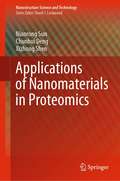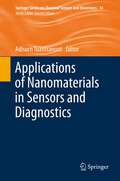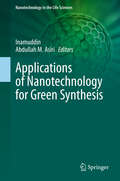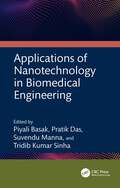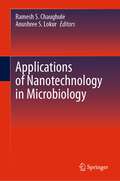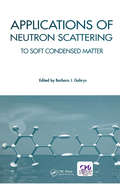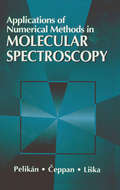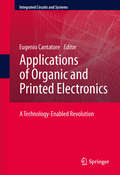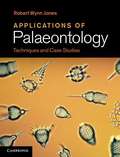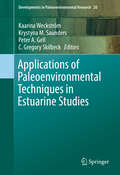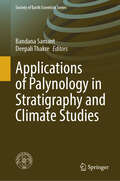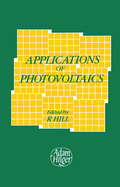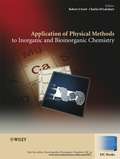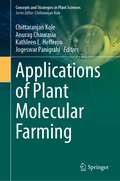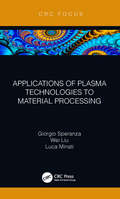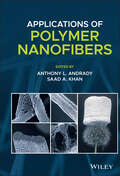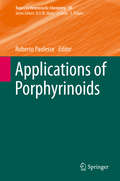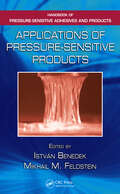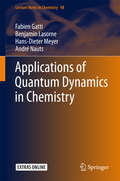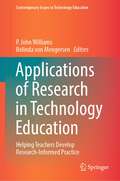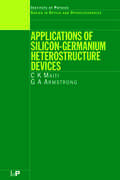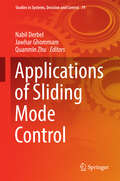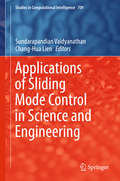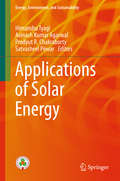- Table View
- List View
Applications of Nanomaterials in Proteomics (Nanostructure Science and Technology)
by Nianrong Sun Chunhui Deng Xizhong ShenThis book provides a comprehensive and systematic overview of the latest advances in nanomaterials for proteomics, both theoretical and practical. Consisting of seven chapters, it first covers the synthesis methods, characterization, principles, and performance of functional nanomaterials in various branches of proteomics in detail. This is followed by the applications of nanomaterials for the separation and analysis of various proteins and peptides. Given its scope, the book appeals to a broad readership, including those active in proteomics and materials science; it can also serve as a reference book for students majoring in proteomics analysis.
Applications of Nanomaterials in Sensors and Diagnostics (Springer Series on Chemical Sensors and Biosensors #14)
by Adisorn TuantranontRecent progress in the synthesis of nanomaterials and our fundamental understanding of their properties has led to significant advances in nanomaterial-based gas, chemical and biological sensors. Leading experts around the world highlight the latest findings on a wide range of nanomaterials including nanoparticles, quantum dots, carbon nanotubes, molecularly imprinted nanostructures or plastibodies, nanometals, DNA-based structures, smart nanomaterials, nanoprobes, magnetic nanomaterials, organic molecules like phthalocyanines and porphyrins, and the most amazing novel nanomaterial, called graphene. Various sensing techniques such as nanoscaled electrochemical detection, functional nanomaterial-amplified optical assays, colorimetry, fluorescence and electrochemiluminescence, as well as biomedical diagnosis applications, e.g. for cancer and bone disease, are thoroughly reviewed and explained in detail. This volume will provide an invaluable source of information for scientists working in the field of nanomaterial-based technology as well as for advanced students in analytical chemistry, biochemistry, electrochemistry, material science, micro- and nanotechnology.
Applications of Nanotechnology for Green Synthesis (Nanotechnology in the Life Sciences)
by Inamuddin Abdullah M. AsiriTraditional methods in synthetic chemistry produce chemical waste and byproducts, yield smaller desired products, and generate toxic chemical substances, but the past two centuries have seen consistent, greener improvements in organic synthesis and transformations. These improvements have contributed to substance handling efficiency by using green-engineered forerunners like sustainable techniques, green processes, eco-friendly catalysis, and have minimized energy consumption, reduced potential waste, improved desired product yields, and avoided toxic organic precursors or solvents in organic synthesis. Green synthesis has the potential to have a major ecological and monetary impact on modern pharmaceutical R&D and organic chemistry fields. This book presents a broad scope of green techniques for medicinal, analytical, environmental, and organic chemistry applications. It presents an accessible overview of new innovations in the field, dissecting the highlights and green chemistry attributes of approaches to green synthesis, and provides cases to exhibit applications to pharmaceutical and organic chemistry. Although daily chemical processes are a major part of the sustainable development of pharmaceuticals and industrial products, the resulting environmental pollution of these processes is of worldwide concern. This edition discusses green chemistry techniques and sustainable processes involved in synthetic organic chemistry, natural products, drug syntheses, as well various useful industrial applications.
Applications of Nanotechnology in Biomedical Engineering
by Suvendu Manna Piyali Basak Pratik Das Tridib Kumar SinhaThis book presents recent advancements in nanotechnology-based innovations in the biomedical sciences and engineering fields, including nanoimaging, nano-delivery of drugs and genes, antimicrobial and antiviral coatings, nano-neutraceuticals, and nano-cosmetics. It covers a wide range of topics, which include nanosensors, nano-based coatings, and wound healing, as well as scope for new research and development. It is a guide to the state-of-the-art nanotechnological advancements in medical image processing and disease detection. Features are as follows: Covers industry-oriented applications of nanomaterials in the field of biomedical engineering Discusses development of nature-inspired nano-engineered nutraceuticals Reviews research on nano-coating to restrict biofilm formation and nosocomial infections Includes different aspects of both medical sciences and health sciences, ranging from medical imaging to cosmetics Explores micro-/nano-SMART devices for biomedical applications This book is aimed at researchers and graduate students in biomedical engineering, nanotechnology, and related areas.
Applications of Nanotechnology in Microbiology
by Ramesh S. Chaughule Anushree S. LokurThis book discusses the applications of nanotechnology in clinical microbiology, food microbiology, and green solutions of nanoparticles using microorganisms for a range of benefits. It describes nanotechnology’s rapid progress in the development of materials used in industry, medicine, drug delivery, and dentistry. The authors further explore how microbiology and nanotechnology separately have proven to be effective for human health solutions keeping an ecological and environmental balance. Domains covered include environmental microbiology, medical microbiology, food microbiology (to control food spoilage), biosynthesis of nanomaterials using microorganisms, water microbiology, nanofluidic devices for isolation and analysis of individual biomolecules such as DNA that can lead to a new detection scheme for cancer, and various fields such as pharmacy, clinical research, agriculture etc. This book will be essential reading to a wide range of scholars and researchers interested in microbiology along with nanotechnology applications for efficient solutions to cancer detection, biosensors, vaccines research, agriculture, wastewater management etc.
Applications of Neutron Scattering to Soft Condensed Matter
by Barbara J. GabrysNeutrons, which are a penetrating yet non destructive probe, are ideally suited to studying the structure, organisation and motion of molecules responsible for the physical properties of materials under a variety of conditions. Applications are in fields as diverse as colloid and polymer science, earth sciences, pharmaceutics, biology and engineeri
Applications of Numerical Methods in Molecular Spectroscopy
by Peter Pelikan Michal Ceppan Marek LiskaApplications of Numerical Methods in Molecular Spectroscopy provides a mathematical background, theoretical perspective, and review of spectral data processing methods. The book discusses methods of complex spectral profile separation into bands, factor analysis methods, methods of quantitative analysis in molecular spectroscopy and reflectance spectroscopy, and new data processing methods. Mathematical methods in special areas of molecular spectroscopy, such as color science, electron spin resonance, and nuclear magnetic resonance spectroscopies are also covered. The book will benefit researchers and postgraduate students in fields of chemistry, physics, and biology.
Applications of Organic and Printed Electronics: A Technology-Enabled Revolution (Integrated Circuits and Systems)
by Eugenio CantatoreOrganic and printed electronics can enable a revolution in the applications of electronics and this book offers readers an overview of the state-of-the-art in this rapidly evolving domain. The potentially low cost, compatibility with flexible substrates and the wealth of devices that characterize organic and printed electronics will make possible applications that go far beyond the well-known displays made with large-area silicon electronics. Since organic electronics are still in their early stage, undergoing transition from lab-scale and prototype activities to production, this book serves as a valuable snapshot of the current landscape of the different devices enabled by this technology, reviewing all applications that are developing and those can be foreseen.
Applications of Palaeontology
by Robert Wynn JonesPalaeontology, the scientific study of fossils, has developed from a descriptive science to an analytical science used to interpret relationships between earth and life history. This book provides a comprehensive and thematic treatment of applied palaeontology, covering the use of fossils in the ordering of rocks in time and in space, in biostratigraphy, palaeobiology and sequence stratigraphy. Robert Wynn Jones presents a practical workflow for applied palaeontology, including sample acquisition, preparation and analysis, and interpretation and integration. He then presents numerous case studies that demonstrate the applicability and value of the subject to areas such as petroleum, mineral and coal exploration and exploitation, engineering geology and environmental science. Specialist applications outside of the geosciences (including archaeology, forensic science, medical palynology, entomopalynology and melissopalynology) are also addressed. Abundantly illustrated and referenced, Applications of Palaeontology provides a user-friendly reference for academic researchers and professionals across a range of disciplines and industry settings.
Applications of Palaeontology: Techniques and Case Studies
by Robert Wynn JonesPalaeontology, the scientific study of fossils, has developed from a descriptive science to an analytical science used to interpret relationships between earth and life history. This book provides a comprehensive and thematic treatment of applied palaeontology, covering the use of fossils in the ordering of rocks in time and in space, in biostratigraphy, palaeobiology and sequence stratigraphy. Robert Wynn Jones presents a practical workflow for applied palaeontology, including sample acquisition, preparation and analysis, and interpretation and integration. He then presents numerous case studies that demonstrate the applicability and value of the subject to areas such as petroleum, mineral and coal exploration and exploitation, engineering geology and environmental science. Specialist applications outside of the geosciences (including archaeology, forensic science, medical palynology, entomopalynology and melissopalynology) are also addressed. Abundantly illustrated and referenced, Applications of Palaeontology provides a user-friendly reference for academic researchers and professionals across a range of disciplines and industry settings.
Applications of Paleoenvironmental Techniques in Estuarine Studies (Developments in Paleoenvironmental Research #Volume 20)
by Kaarina Weckström Krystyna M. Saunders Peter A. Gell C. Gregory SkilbeckThe aim of this edited volume is to introduce the scientific community to paleoenvironmental studies of estuaries, to highlight the types of information that can be obtained from such studies, and to promote the use of paleoenvironmental studies in estuarine management. <P><P> Readers will learn about the the application of different paleoecological approaches used in estuaries that develop our understanding of their response to natural and human influences. Particular attention is given to the essential steps required for undertaking a paleoecological study, in particular with regard to site selection, core extraction and chronological techniques, followed by the range of indicators that can be used. A series of case studies are discussed in the book to demonstrate how paleoecological studies can be used to address key questions, and to sustainably manage these important coastal environments in the future. This book will appeal to professional scientists interested in estuarine studies and/or paleoenvironmental research, as well as estuarine managers who are interested in the incorporation of paleoenvironmental research into their management programs.
Applications of Palynology in Stratigraphy and Climate Studies (Society of Earth Scientists Series)
by Bandana Samant Deepali ThakreThis book highlights the importance of palynology in understanding floral biodiversity, paleoclimate and depositional environments in deep time and recent sediments. It includes contributions from renowned Indian palynologists who work on the applied aspects of palynology. The book focuses on the significance of palynology in solving various geological problems, ranging from the Precambrian to the Recent. This book will be useful to graduate and postgraduate students, researchers, and academicians working in geology and botany, as well as international researchers interested in palynological research work in India.
Applications of Photovoltaics
by R HillPhotovoltaics (PV) play a vital role in an energy-conscious society where the demand for cheap, convenient, and environmentally benign sources of energy is certain to increase. The range of applications is immense, encompassing many spheres of activity, from modern consumer electronics to the supply of power. Bringing together experts in their fields, Applications of Photovoltaics provides a stimulating account of the technical and economic aspects of the many areas that PV technology has been or is soon to be implemented. The book includes chapters on terrestrial applications of PV; PV for development, placing PV in the context of an energy policy for developing countries; PV for developing countries, which discusses the techno-economics of PV applications; PV systems for professional applications, which include hybrid systems; and low-power applications of PV for consumer, leisure, and other systems. Applications of Photovoltaics is appealing to all engineers, from energy advisors and policy makers, with an interest in or need for off-grid electrical supplies, from microwatts to megawatts. Its level of presentation makes it accessible to those without an engineering or economics background.
Applications of Physical Methods to Inorganic and Bioinorganic Chemistry
by Robert A. Scott Charles M. LukehartModern spectroscopic and instrumental techniques are essential to the practice of inorganic and bioinorganic chemistry. This first volume in the new Wiley Encyclopedia of Inorganic Chemistry Methods and Applications Series provides a consistent and comprehensive description of the practical applicability of a large number of techniques to modern problems in inorganic and bioinorganic chemistry. The outcome is a text that provides invaluable guidance and advice for inorganic and bioinorganic chemists to select appropriate techniques, whilst acting as a source to the understanding of these methods.This volume is also available as part of Encyclopedia of Inorganic Chemistry, 5 Volume Set.This set combines all volumes published as EIC Books from 2007 to 2010, representing areas of key developments in the field of inorganic chemistry published in the Encyclopedia of Inorganic Chemistry. Find out more.
Applications of Plant Molecular Farming (Concepts and Strategies in Plant Sciences)
by Chittaranjan Kole Anurag Chaurasia Kathleen L. Hefferon Jogeswar PanigrahiThis edited book is a comprehensive compilation of applications of plant molecular farming in various fields including agriculture, industry and medicine, using different plant/crop systems as bioreactors for the bulk production of products of interest. The book places special emphasis on plant molecular farming being utilized for the bulk production of biologics, industrial enzymes, vaccines, drugs and recombinant pharmaceutical proteins.Plant molecular farming (PMF) is an upcoming promising interdisciplinary subject, and therefore the book contains contributions from experts across the disciplines. The utilization of plant viral vectors to produce biologics, virus-like particles and antimicrobial peptides via PMF have been highlighted. Molecular farming for the bulk production of recombinant pharmaceutical proteins and various types of human and veterinary vaccines in different crops/plants and genetically modified seeds has been included. The process of scaling up to manufacturing capacity, product formation by bioprocessing of plant cell suspension culture, and bioreactor engineering have been incorporated. Lastly, the book provides special coverage on utilizing PMF made products to control neglected tropical diseases and plant-made antigens as immunotherapies for allergic and autoimmune diseases.The book has chapters from leading experts on the subject, making it equally beneficial for researchers, policy planners, industrialists, medical professionals, entrepreneurs, and students of various related disciplines.
Applications of Plasma Technologies to Material Processing
by Wei Liu Giorgio Speranza Luca MinatiThis book provides a survey of the latest research and developments in plasma technology. In an easy and comprehensive manner, it explores what plasma is and the technologies utilized to produce plasma. It then investigates the main applications and their benefits. Different from other books on the topic that focus on specific aspects of plasma technology, the intention is to provide an introduction to all aspects related to plasma technologies. This book will be an ideal resource for graduate students studying plasma technologies, in addition to researchers in physics, engineering, and materials science Features Accessible and easy to understand Provides simple yet exhaustive explanations of the foundations Explores the latest technologies and is filled with practical applications and case studies
Applications of Polymer Nanofibers
by Anthony L. Andrady Saad A. KhanAPPLICATIONS OF POLYMER NANOFIBERS Explore a comprehensive review of the practical experimental and technological details of polymer nanofibers with a leading new resource Applications of Polymer Nanofibers delivers a complete introduction to the basic science of polymer nanofibers as well as a review of their diverse applications. The book assesses their potential for commercialization and presents contributions from leading experts emphasizing their practical and technological details. New and up to date research findings are presented throughout the book in areas including filters, fabric, energy, fuel cells, batteries, sensors, biomedicine, drug delivery, tissue engineering, and wound dressings. The book also presents a fulsome analysis of the technology of electrospinning, the most convenient and scalable technique for nanofiber production. It also provides readers with practical information on relevant surface modification techniques. Applications of Polymer Nanofibers effectively balances theoretical background with practical applications of the technology, including insights into polymer nanofiber materials that will be useful for advanced students and researchers. Students, researchers, and industry professionals will also enjoy the inclusion of: A thorough introduction to electrospinning parameters and resulting nanofiber characteristics, including theoretical and practical considerations An exploration of textile applications of nanofibers, like protective clothing, filter fabrics, wearable devices, functional fabrics, and biomedical textiles A review of nanofiber mats as high-efficiency filters, including filtration developments, filters made with nanofibers, and the future outlook for nanofiber filters A treatment of nanofiber-based chemical sensors, including sensor materials, approaches to nanofiber sensor design, and gravimetric nanofiber sensors Perfect for researchers and graduate students studying polymer science and engineering, chemical engineering, materials science, and nanotechnology. Applications of Polymer Nanofibers will also earn a place in the libraries of industrial researchers concerned with electrospinning, air filtration, fabrics, drug delivery, catalysis, and biomedicine.
Applications of Porphyrinoids (Topics in Heterocyclic Chemistry #34)
by Roberto PaolesseThe series Topics in Heterocyclic Chemistry presents critical reviews on present and future trends in the research of heterocyclic compounds. Overall the scope is to cover topics dealing with all areas within heterocyclic chemistry, both experimental and theoretical, of interest to the general heterocyclic chemistry community. The series consists of topic related volumes edited by renowned editors with contributions of experts in the field. All chapters from Topics in Heterocyclic Chemistry are published Online First with an individual DOI. In references, Topics in Heterocyclic Chemistry is abbreviated as Top Heterocycl Chem and cited as a journal.
Applications of Pressure-Sensitive Products (Handbook of Pressure-Sensitive Adhesives and Products)
by Mikhail M. Feldstein IstvÁn BenedekPresenting the end-use and application technologies of pressure-sensitive adhesives and products, Volume Three of the Handbook of Pressure-Sensitive Adhesives and Products discusses the build up and classes
Applications of Quantum Dynamics in Chemistry (Lecture Notes in Chemistry #98)
by Fabien Gatti Benjamin Lasorne Hans-Dieter Meyer André NautsThis book explains the usage and application of Molecular Quantum Dynamics, the methodology where both the electrons and the nuclei in a molecule are treated with quantum mechanical calculations. This volume of Lecture Notes in Chemistry addresses graduate students and postdocs in the field of theoretical chemistry, as well as postgraduate students, researchers and teachers from neighboring fields, such as quantum physics, biochemistry, biophysics, or anyone else who is interested in this rising method in theoretical chemistry, and who wants to gain experience in the opportunities it can offer. It can also be useful for teachers interested in illustrative examples of time-dependent quantum mechanics as animations of realistic wave packets have been designed to assist in visualization. Assuming a basic knowledge about quantum mechanics, the authors link their explanations to recent experimental investigations where Molecular Quantum Dynamics proved successful and necessary for the understanding of the experimental results. Examples including reactive scattering, photochemistry, tunneling, femto- and attosecond chemistry and spectroscopy, cold chemistry or crossed-beam experiments illustrate the power of the method. The book restricts complicated formalism to the necessary and in a self-contained and clearly explained way, offering the reader an introduction to, and instructions for, practical exercises. Continuative explanation and math are optionally supplemented for the interested reader. The reader learns how to apply example simulations with the MCTDH program package (Multi Configuration Time Dependent Hartree calculations). Readers can thus obtain the tools to run their own simulations and apply them to their problems. Selected scripts and program code from the examples are made available as supplementary material. This book bridges the gap between the existing textbooks on fundamental theoretical chemistry and research monographs focusing on sophisticated applications. It is a must-read for everyone who wants to gain a sound understanding of Molecular Quantum Dynamics simulations and to obtain basic experience in running their own simulations.
Applications of Research in Technology Education: Helping Teachers Develop Research-Informed Practice (Contemporary Issues in Technology Education)
by P. John Williams Belinda Von MengersenThis book brings together significant international research in technology education through a focus on contemporary Ph.D. theses. It highlights the conceptual underpinnings and methodology of each research project and elaborates on how the findings are relevant for practitioners. This book addresses the common disjunction between research conducted and an awareness of that research by practitioners. It examines the extent to which the research aligns with different justifications for teaching technology in schools in economic, utilitarian, democratic, cultural, and other such contexts.
Applications of Silicon-Germanium Heterostructure Devices (Series in Optics and Optoelectronics)
by C.K Maiti G.A ArmstrongThe first book to deal with the design and optimization of transistors made from strained layers, Applications of Silicon-Germanium Heterostructure Devices combines three distinct topics-technology, device design and simulation, and applications-in a comprehensive way. Important aspects of the book include key technology issues for the growth of st
Applications of Sliding Mode Control (Studies in Systems, Decision and Control #79)
by Quanmin Zhu Nabil Derbel Jawhar GhommamThis book presents essential studies and applications in the context of sliding mode control, highlighting the latest findings from interdisciplinary theoretical studies, ranging from computational algorithm development to representative applications. Readers will learn how to easily tailor the techniques to accommodate their ad hoc applications. To make the content as accessible as possible, the book employs a clear route in each paper, moving from background to motivation, to quantitative development (equations), and lastly to case studies/illustrations/tutorials (simulations, experiences, curves, tables, etc. ). Though primarily intended for graduate students, professors and researchers from related fields, the book will also benefit engineers and scientists from industry.
Applications of Sliding Mode Control in Science and Engineering (Studies in Computational Intelligence #709)
by Sundarapandian Vaidyanathan Chang-Hua LienGathering 20 chapters contributed by respected experts, this book reports on the latest advances in and applications of sliding mode control in science and engineering. The respective chapters address applications of sliding mode control in the broad areas of chaos theory, robotics, electrical engineering, physics, chemical engineering, memristors, mechanical engineering, environmental engineering, finance, and biology. Special emphasis has been given to papers that offer practical solutions, and which examine design and modeling involving new types of sliding mode control such as higher order sliding mode control, terminal sliding mode control, super-twisting sliding mode control, and integral sliding mode control. This book serves as a unique reference guide to sliding mode control and its recent applications for graduate students and researchers with a basic knowledge of electrical and control systems engineering.
Applications of Solar Energy (Energy, Environment, and Sustainability)
by Avinash Kumar Agarwal Himanshu Tyagi Prodyut R. Chakraborty Satvasheel PowarThis book focuses on solar-energy-based renewable energy systems and discusses the generation of electric power using solar photovoltaics, as well as some new techniques, such as solar towers, for both residential and commercial needs. Such systems have played an important role in the move towards low-emission and sustainable energy sources. The book covers a variety of applications, such as solar water heaters, solar air heaters, solar drying, nanoparticle-based direct absorption solar systems, solar volumetric receivers, solar-based cooling systems, solar-based food processing and cooking, efficient buildings using solar energy, and energy storage for solar thermal systems. Given its breadth of coverage, the book offers a valuable resource for researchers, students, and professionals alike.
